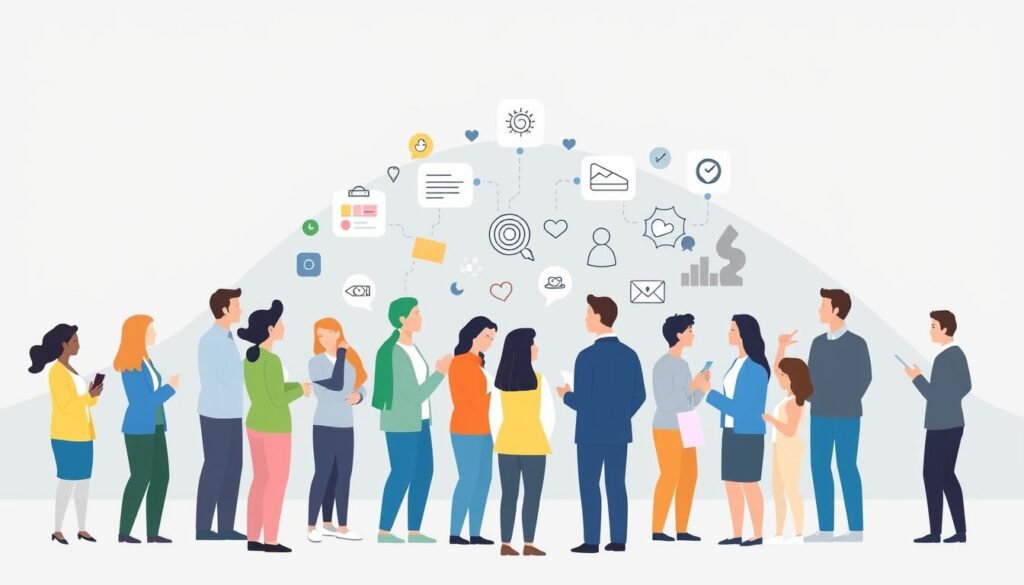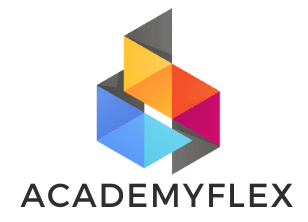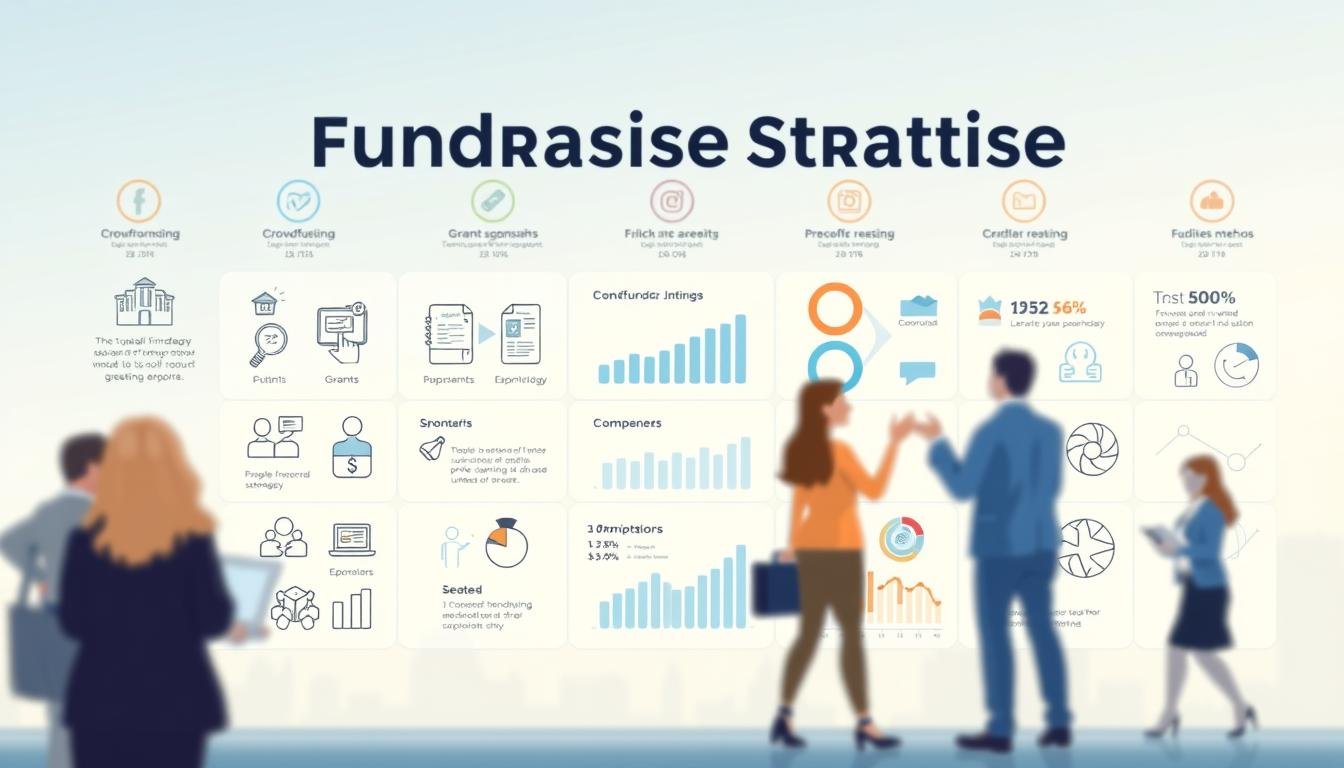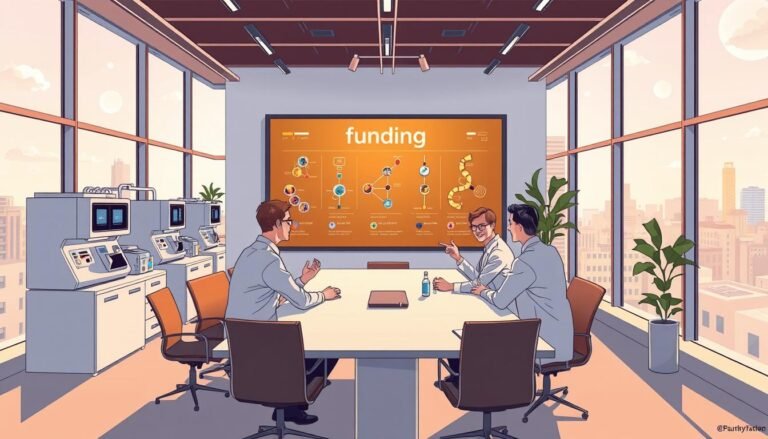Fundraising strategies
Did you know that 80% of a nonprofit’s revenue often comes from just 20% of its donors? This shows how crucial smart fundraising strategies are. Whether you’re leading a school PTA drive or a national nonprofit fundraising strategy, having a clear plan is key. It turns chaos into clarity.
Imagine a campaign where every dollar matters and every donor feels appreciated. This guide will show you how to make it happen.
Key Takeaways
- Focus on major donors who contribute the largest gifts to maximize impact.
- Matching gift programs can double donations instantly when donors’ employers participate.
- Personalized stewardship, like handwritten notes, strengthens donor loyalty.
- Capital campaigns drive significant one-time gifts for urgent projects.
- Health and human services nonprofits benefit most from corporate partnerships, securing 26% of corporate donations over 20 years.
A well-crafted fundraising strategy is more than a to-do list—it’s a roadmap. It helps nonprofits avoid guesswork and align efforts with their mission. This guide covers proven methods, from cultivating major gifts to using digital tools. You can raise more funds without stress. Let’s start building your plan today.
Understanding the Fundamentals of Fundraising
Before you dive into fundraising strategies, learn the basics. These basics are what make a good idea into a successful campaign. It all starts with knowing how people act and how groups work.
The Psychology Behind Giving
Donors give when they feel a connection. Studies show 70% of givers choose causes that match their values. Important factors include:
- Trust: Being open about where donations go
- Impact: Showing how gifts help
- Recognition: Saying thank you in a way that feels right
Building Your Fundraising Foundation
Start strong with these steps:
- Make a clear case for support by showing how your mission works
- Use moves management to guide donors from start to finish
- Have a integrated development plan that ties everything together
Key Stakeholders in the Fundraising Process
Successful teams have:
- Boards: They lead, support diversity, and speak up for your cause
- Staff: They carry out plans like appeals and big gift campaigns
- Volunteers: They help spread the word through their networks
- Donors: They need to feel valued to keep giving
By including these parts, your effective fundraising techniques will work for everyone. Begin by laying the groundwork before you grow your efforts.
Assessing Your Organization’s Fundraising Needs
Effective fundraising campaign planning begins with knowing your organization’s needs. Look back at past efforts to see what worked and what didn’t. Ask yourself: Who are our biggest donors? Which ways get the most people involved? What campaigns didn’t meet their goals?
Looking at past results can guide future success. Check data like how well you keep donors and how much each campaign makes. For example, if emails get more donations than social media, focus on improving your online outreach. The nonprofit fundraising strategies you pick should match your team’s skills. Do you have people good at planning events or getting big donations?
- Use a gift pyramid to balance goals: 88% of donations often come from major donors, so focus on keeping these relationships strong.
- Update donor databases regularly—63% of gifts now happen online, so make sure your site is easy to use.
- Make sure your strategy fits your mission. If your cause is about education, share stories that appeal to education-focused foundations.
First, check what resources you have now. Can your team handle new tools? Do you need training in writing grants or planning events? A smart plan avoids overworking your team. Build a strategy that grows with your organization, covering donor communication, event planning, and partnerships. This solid base will help every effort move you closer to your mission.
Creating a Compelling Case for Support
A well-crafted case for support turns donor curiosity into commitment. It’s your chance to mix your mission with data-driven storytelling. By focusing on donor engagement strategies and effective fundraising techniques, your case becomes a tool that drives action. Whether it’s for a new building or a community program, every detail should match your goals.
| Element | Description |
|---|---|
| Vision | Long-term goals (e.g., “Provide clean water to 100,000 people by 2025”) |
| Priorities | Specific projects like HVAC upgrades or education programs |
| Impact | Measurable outcomes like “50% drop in malnutrition rates” |
| Call to Action | Steps like “Donate $100 to fund a water pump today” |
Crafting Your Mission Statement
Start with a mission statement that fits on a business card. For example: “Empowering youth through education and mentorship.” Use action verbs like “build,” “launch,” or “expand.” A clear mission statement guides donor decisions and matches their values.
Developing Powerful Impact Stories
Stories should show, not tell. Combine client testimonials with data: “After our program, 85% of students graduated college.” Use quotes like, ‘This scholarship changed my life,’ alongside stats on alumni success. Visuals like photos of renovated classrooms or event photos add credibility.
Communicating Urgent Needs Effectively
Urgency works best when paired with hope. Phrases like “Your gift today funds meals for 50 children this winter” balance urgency and optimism. Avoid generic terms like “We’re desperate” – focus on solutions donors can join. Test messaging with board members to refine clarity.
Remember: a strong case for support avoids generic terms. Use specifics like “replacing outdated HVAC systems” instead of “facility upgrades.” Pair this with clear visuals and a consistent tone to maximize donor trust.
Effective Fundraising Strategies for Nonprofits
Nonprofits do well by mixing old and new ideas. First, figure out what works best for your team. Here’s how to choose the right mix:
Traditional vs. Innovative Approaches
Direct mail and galas are still loved by many. But, innovative fundraising ideas like crypto donations or TikTok challenges draw in the young crowd. For example, a wildlife group made $250k with a “Save the Species” dance challenge online. Mixing old and new is key.
Matching Strategies to Your Organization Size
Small teams can make a big impact with smart, low-cost plans. Here are some ideas for different sizes:
- Small nonprofits: Use peer-to-peer networks or local business sponsorships
- Mid-sized: Try hybrid galas with online auctions
- Larger orgs: Go for major gift campaigns or corporate partnerships
Adapting for Different Causes
Each cause needs its own approach. For example, educational groups might host scholarship galas. Environmental groups could focus on tree-planting pledges. Here are some ideas for different causes:
- Health nonprofits: Host telethons or sell wearable merchandise
- Arts orgs: Offer pay-what-you-want tickets
- Community groups: Create neighborhood crowdfunding maps
The best nonprofit fundraising strategies change with your community’s needs. Always test, measure, and adjust to keep support strong.
Developing Your Fundraising Calendar
Effective fundraising campaign planning starts with a well-structured calendar. This tool ensures every activity aligns with your nonprofit’s mission. It also maximizes donor engagement. Start by mapping out key activities like annual appeals, events, and grant deadlines.
Consider seasonal trends—donors give more during holidays or Giving Tuesday—when scheduling. This can boost your impact.
- Set clear, measurable goals tied to your financial targets.
- Assign staff roles and deadlines for tasks like donor outreach or event prep.
- Leave buffer weeks between campaigns to avoid overwhelming donors.
| Phase | Activity | Timing | Team Lead |
|---|---|---|---|
| Planning | Goal-setting workshops | January | Executive Director |
| Execution | Spring gala planning | March–April | Events Coordinator |
| Review | Performance analysis | November | Finance Team |
Regular check-ins every 60 days help adjust fundraising strategies based on real-time data. Include stewardship moments like thank-you campaigns between big asks. This keeps donor connections strong.
Flexibility is key—reserve 10% of your budget for unplanned opportunities or delays. A well-organized calendar turns chaos into clarity. It ensures every effort moves your mission forward.
Digital Fundraising Techniques That Drive Results
More than 63% of donors like to give online, making digital strategies key for nonprofits. Online fundraising best practices and innovative fundraising ideas help turn visitors into supporters. This section shows how to use websites, social media, and emails to increase donations.
Optimizing Your Online Donation Process
Make giving easy with mobile-friendly forms. Best practices include:
- Mobile-responsive design (57% of traffic comes from phones)
- Short forms (3-4 fields max)
- Recurring donation options to build loyalty
Leveraging Social Media for Fundraising
Engage Gen Z and millennials with video stories and challenges. Innovative ideas like social media takeovers or TikTok campaigns can double engagement. Use platforms to share impact stories and donation links.
Email Campaigns That Convert
AI-driven emails from tools like Gravyty boosted Saint Leo University’s donations by 42%. Segment lists by donor history and send personalized asks. Highlight urgent needs with subject lines like “Your gift changes lives today.”
Crowdfunding Best Practices
GoFundMe campaigns thrive with real-time progress updates. Pair with Google Ad Grants ($10k/month for nonprofits) to amplify reach. Include leaderboards and employer match reminders to drive urgency.
Planning Successful Fundraising Events
Planning a gala, auction, or virtual challenge needs careful thought. Fundraising event promotion aims to draw in supporters and increase donations. Begin by understanding what your audience likes through surveys and past event data. Use tools like Bloomerang and Qgiv to see what donors are interested in, making sure your event matches their passions.
Decide if your event will be online, in-person, or a mix. Online events can reach people worldwide with tools like mobile bidding platforms. In-person events build community through direct interactions. Hybrid events aim to reach more people while keeping the personal touch. Here are some effective fundraising techniques:
- Use text-to-give platforms for instant donations during live events
- Design themes tied to your mission, like a “Race for a Cure” 5K
- Incorporate real-time donor recognition screens to highlight contributions
It’s important to follow up after the event. Send thank-you messages within 48 hours, share photos, and invite people to join your monthly giving program. Use event management software to track how well your event did and improve future ones. Remember, 68% of donors like events with interactive parts—focus on engaging them, not just having them there.
Building Sustainable Donor Relationships
Only 13.8% of first-time donors come back, making donor retention tactics key. Building lasting relationships starts with showing donors their gifts make a difference. Personalized thank-yous, updates, and recognition programs turn donations into partnerships.

Good donor engagement strategies start with knowing why donors give. Sort your list by their past giving, interests, and how they like to be contacted. Tools like WildApricot help track and automate these efforts. For instance, sending birthday wishes or celebrating donation anniversaries can deepen connections.
- Share reports on how donations help. Make sure the content matches what donors care about—like healthcare, education, or the environment.
- Give donors ways to get involved, like volunteering or joining advisory boards. This builds loyalty and trust.
- Always respond to feedback quickly. Younger donors might prefer digital updates over mail.
Keep your promises: if you said you’d send monthly updates, do it. Share stories of lives changed, not just financial reports. Reach out to lapsed donors by looking at their past giving and inviting them to events or new campaigns. When donors feel valued and heard, they become champions, not just donors.
Corporate Partnerships and Sponsorships
Forming strong bonds with companies can boost your nonprofit’s visibility. It also gives businesses a chance to support important causes. These partnerships are key to successful fundraising strategies, creating value for everyone involved.
Identifying Aligned Corporate Partners
Begin by looking for companies that share your nonprofit’s values. Use tools like CSRHub to find out what they care about. For example, a food bank might team up with Kroger to cut down on food waste.
Choose companies with experience in fundraising campaign planning in your field.
- Check corporate annual reports for philanthropy focuses
- Review employee volunteer programs like Salesforce’s “1-1-1 Model”
- Attend industry events where corporate CSR leaders network
Win-Win Proposals That Deliver Results
Make sure your proposals show how both sides will benefit. Suggest joint campaigns or programs that engage employees. Starbucks’ “Good Night Community Grants” are a great example of how sponsorships can help specific programs and boost brand image.
Include specific goals, like:
- Matching gift programs increasing donor participation
- Volunteer days improving community impact
- In-kind donations reducing operational costs
Building Lasting Relationships
Keep your partners updated with regular reports on your impact. Host joint events and share sponsorships on social media. Use tools like Foundation Directory to track your progress and stay aligned with your partners’ goals.
Grant Writing and Foundation Funding
Grants are key for nonprofit fundraising strategies, providing steady support for programs and operations. Foundations gave $105.21 billion in 2022. To get these funds, you need a solid plan. Start by finding funders that match your mission, like the Bill & Melinda Gates Foundation or Ford Foundation.
A good grant proposal has five parts: introduction, problem statement, goals, methods, and budget. For example, explain how a $50,000 grant will help underserved communities. Make sure to use clear language about what you plan to achieve.
| Grant Type | Purpose | Example |
|---|---|---|
| Program Grants | Fund specific initiatives | After-school tutoring programs |
| Operating Grants | Support overhead costs | Staff salaries or facility upkeep |
| Capacity-Building Grants | Strengthen organizational infrastructure | CRM system upgrades |
Good fundraising means avoiding common mistakes. Never send a proposal without checking with the funder first. Also, always follow the rules. A 2023 study found 68% of proposals were rejected for not following guidelines.
Build relationships by attending webinars and asking for feedback. Use a grants calendar to keep track of deadlines. Also, reuse parts of successful proposals for other applications. Grants should be 10-20% of your budget. With the right approach, even small nonprofits can get the support they need.
Peer-to-Peer Fundraising: Empowering Your Supporters
Peer-to-peer fundraising turns supporters into advocates. These campaigns let people raise funds using their networks. This boosts reach and trust. With peer-to-peer programs growing 3.2% in 2023, they’re a proven way to engage communities. Here’s how to maximize impact:
Setting Up Successful P2P Campaigns
Choose platforms like Bloomerang or Qgiv for tools like central campaign pages and social sharing. Innovative fundraising ideas include 5Ks, virtual challenges, and merchandise sales. Example campaigns like polar plunges or giving days drive engagement. Ensure your platform offers:
| Feature | Bloomerang | Qgiv |
|---|---|---|
| Fundraising Event Setup | ✅ Custom event templates | ✅ Live donation tracking |
| Team Tools | ✅ Group fundraising dashboards | ✅ Team challenge options |
Training and Support
- Provide pre-written emails, social posts, and video guides.
- Host virtual training sessions on campaign goals and platform use.
- Offer a resource library with brand guidelines and design assets.
Recognizing Volunteers
Public shoutouts, certificates, or exclusive events reward top contributors. Tiered incentives like merchandise or recognition tiers boost motivation. For example:
- Badges for reaching milestones.
- Feature top fundraisers in newsletters.
- Host a virtual celebration event.
By combiningfundraising event promotiontools with personalized recognition, peer-to-peer programs build lasting relationships. With 92% of donors trusting peer recommendations, this strategy amplifies your reach and impact.
Measuring Fundraising Success: Key Metrics and KPIs
Tracking the right metrics is key to growing your fundraising efforts. Start by focusing on actionable KPIs that show what moves your mission forward. Don’t get caught up in numbers like total website visitors. Instead, focus on data that shows how donors behave and helps reach your goals.
- Donor retention rate: How many supporters give again after their first gift.
- Average gift size: Total donations divided by donor count. A 10% annual increase shows improved donor engagement.
- Cost per dollar raised (CPDR): Expenses divided by revenue. Aim for CPDR under 0.25 for efficient fundraising.
- Email conversion rates: Track clicks-to-donations to refine online fundraising best practices.
Use these numbers to spot trends. For example, a rising donor churn rate might mean you need to do a better job of keeping donors. Pair metrics like recurring gift percentage with donor surveys to find out why supporters stay or leave. Tools like Google Analytics and CRM dashboards make tracking easy without needing to be a data expert.
Regularly compare metrics against benchmarks. A 37.5% email conversion rate, for example, could show what’s working or what’s not. If the online gift percentage is lower than others, it might be time to tweak your matching gift programs.
Using data to make changes is powerful. Whether it’s improving a crowdfunding page or refining peer-to-peer campaigns, these numbers guide you. Keep your metrics simple yet precise to make sure every dollar raised helps your mission.
Overcoming Common Fundraising Challenges
Every nonprofit faces challenges like donor burnout, economic swings, and competition. But, smart strategies can turn these obstacles into opportunities. Start by focusing on donor retention tactics that keep supporters engaged over time.
| Challenge | Nonprofit Fundraising Strategies | Action Steps |
|---|---|---|
| Donor Fatigue | Rotate communication channels and share impact stories | Send personalized thank-yous, space out asks, and highlight donor impact |
| Economic Uncertainty | Build adaptable plans with transparency | Use free tools like social media, host virtual events, and share financial updates |
| Competition | Showcase unique mission stories | Create shareable videos, partner with local businesses, and segment donor lists |
To keep donors engaged, mix email newsletters with social media updates. Share impact reports to show progress. During economic dips, focus on low-cost methods like peer-to-peer campaigns.
Use storytelling to stand out—donors remember stories, not just stats. Prioritize transparency in all communications to build trust. Small but consistent efforts can make a big difference. Start with one strategy today!
Innovative Fundraising Ideas for 2023 and Beyond
Donor preferences are changing, and organizations need to find new ways to fundraise. Innovative fundraising ideas like using cryptocurrency and NFT auctions are becoming popular. These methods combine technology with the mission of giving. Let’s explore the trends that will shape the future of giving.
- Crowdfunding NFTs: Sell digital art or collectibles via platforms like NFTforCharity.
- AR Impact Tours: Use augmented reality apps to let donors visualize project outcomes.
- Text-to-Give: Let supporters send donations via SMS with services like Snowball.
| Idea | Description | Example |
|---|---|---|
| Crypto Donations | Accept Bitcoin or Ethereum through platforms like BitGive. | UNICEF’s blockchain donations raised $1.2M in 2022. |
| Virtual 5Ks | Participants track runs via apps; pledges fund your cause. | Charity:Water’s virtual runs raised $2.1M in 2023. |
| Plant-a-Tree Campaigns | Each donation plants trees, combining impact with transparency. | TreeSisters partners with nonprofits for tree-planting per donation. |
Even simple ideas like shoe drives or monthly giving can work. Start with small tests to see what works best. The aim is to match innovative fundraising ideas with your mission. This way, you can build strong relationships with your supporters.
Ethical Considerations in Modern Fundraising
Building trust is key to lasting donor relationships. Ethical practices ensure nonprofits maintain integrity while raising funds. Let’s explore three core principles to guide your efforts:
Transparency in Fundraising Communications
Be clear about how donations are used. Share financial reports showing where funds go. Mention program expenses, administrative costs, and fundraising overhead.
For instance, nonprofits must file IRS Form 990, which details financial activities. Avoid vague statements like “every dollar helps.” Instead, state: “75% of donations go directly to programs.”
Respecting Donor Privacy
Protect donor data as part of online fundraising best practices. Use encryption for credit card info and follow PCI DSS standards. Never share personal details without consent.
Offer opt-out options for emails and updates. Tools like the AFP Donors’ Bill of Rights guide privacy policies.
Balancing Urgency with Honesty
Urgency in appeals must not overshadow truth. Avoid exaggerated claims like “last chance to save lives!” unless backed by facts. Use donor engagement strategies that highlight real impact.
For example, instead of fear-based appeals, share measurable outcomes: “Your gift provides 10 meals this week.”
- Disclose if funds support general operations vs. specific projects.
- Avoid “poverty porn” imagery; focus on community strengths per Change Catalyst’s diversity guidelines.
- Report donor-restricted gifts promptly and honor their intent.
Legal compliance matters. The FTC recently shut down a $110M scam using deceptive calls. Stay compliant with state regulations and IRS rules to avoid penalties. Ethical fundraising isn’t just policy—it’s the foundation of trust.
Conclusion: Putting Your Fundraising Strategies into Action
Every nonprofit’s journey starts with clear fundraising plans. Begin by setting your main goals and making a plan to achieve them. Focus on keeping donors engaged with personalized messages and updates on how their money helps.
Start with simple steps like email campaigns or getting your supporters to help spread the word. This approach can make a big difference.
Use data to make smart choices. With $42.68 billion in planned giving in 2023, look into estate planning tools. Don’t miss out on corporate matching gifts, where billions go unclaimed each year.
December is a great time to increase donations, with Giving Tuesday being a key day.
Technology is crucial. Over half of nonprofits use AI for better data analysis and to connect with donors. But don’t forget the importance of a personal touch, like handwritten thank-you notes.
Transparency and telling your story well are key to keeping donors.
Whether you’re starting new or improving what you do, keep your mission in mind. Small actions, like making your donation page better or training volunteers, can add up. Download our free action plan template to help plan your next steps.
By combining new ideas with genuine sincerity, you can build strong partnerships that support your cause. Every dollar counts and brings you closer to your goal.
Source Links
- Major Donor Fundraising: How to Strengthen Your Strategy – https://www.donorsearch.net/resources/major-donor-fundraising/
- Corporate Fundraising Strategies for Nonprofits | CCS Fundraising – https://www.ccsfundraising.com/insights/nonprofit-corporate-fundraising-strategies/
- Fundraising Fundamentals – CCS Fundraising – https://www.ccsfundraising.com/fundraising-fundamentals/
- AFP Fundamentals of Fundraising Course | Association of Fundraising Professionals – https://afpglobal.org/fundamentals-fundraising
- Donorly — Fundraising Strategy for Beginners: How to Create Your Own – https://donorly.com/thedonorlyblog/fundraising-strategy-guide
- How To Develop A Successful Nonprofit Fundraising Strategy – https://bloomerang.co/blog/fundraising-strategy/
- Your Guide to Writing a Compelling Case for Support – CCS Fundraising – https://www.ccsfundraising.com/insights/writing-a-compelling-case-for-support-four-steps-for-getting-started/
- How to Build a Case for Support – https://doublethedonation.com/case-for-support/
- How to Write a Case for Support: Pro Tips for Driving Impact – Graham-Pelton – https://grahampelton.com/fundraising-case-for-support/
- How to Supercharge Your Fundraising Strategy in 10 Steps – https://alysterling.com/fundraising-strategy/
- 8 Proven Nonprofit Fundraising Strategies – https://www.funraise.org/blog/nonprofit-fundraising-strategies
- 3 Essential Fundraising Strategies for 2023 | Orr Group – https://orrgroup.com/fundraising-strategies-for-nonprofits/
- Designing a Successful Fundraising Calendar + Free Template – https://doublethedonation.com/annual-fundraising-calendar/
- Fundamentals: How to Develop a Year-Round Fundraising Calendar – Winkler Group – https://winklergroup.com/resources-and-events/year-round-fundraising-calendar/
- Digital Fundraising: 10+ Revolutionary Campaign Ideas – https://www.bwf.com/digital-fundraising/
- Digital Fundraising 101: How to Drive Donations Online | Gravyty – https://gravyty.com/blog/digital-fundraising-guide/
- How to Plan a Fundraising Event: 13 Steps to Raise More – https://www.onecause.com/blog/fundraising-event-planning/
- The Ultimate Nonprofit Event Planning Checklist for Success – https://bloomerang.co/blog/nonprofit-event-planning-checklist/
- Donorly — Planning Your Next Nonprofit Fundraising Event: 5 Tips – https://donorly.com/thedonorlyblog/planning-your-next-nonprofit-fundraising-event
- 4 Nonprofit Strategies to Build Donor Trust & Lasting Relationships – Clairification – https://clairification.com/2025/02/17/4-nonprofit-strategies-build-donor-trust-lasting-relationships-2/
- Mastering Donor Development: Essential Strategies for Sustainable Fundraising – WildApricot – https://www.wildapricot.com/blog/donor-development-strategy
- The Fundraiser’s Guide to Powerful Corporate Partnerships – https://doublethedonation.com/corporate-partnerships/
- The Ultimate Guide to Marketing Corporate Sponsorships – https://doublethedonation.com/marketing-corporate-sponsorships/
- Corporate Fundraising: Strategies, Best Practices, and Ideas – https://www.casebook.net/blog/corporate-fundraising-strategies-best-practices-and-ideas/
- Grant Writing 101: What is it & how do you get started? – https://www.learngrantwriting.org/grant-writing-basics/
- Nonprofit Grant Writing: Securing Grants for Your Cause – https://grantsplus.com/insights/blog/grant-writing-support/nonprofit-grant-writing/
- Peer-to-Peer Fundraising 101: Expert Tips for Your Campaigns – https://kindful.com/nonprofit-glossary/peer-to-peer-fundraising/
- Peer-to-Peer Fundraising Best Practices: 12 Essentials – https://www.onecause.com/blog/peer-to-peer-fundraising-best-practices/
- 12 Fundraising Metrics Nonprofits Should Track for Success – The Giving Block – https://thegivingblock.com/resources/fundraising-metrics-nonprofits-measure/
- Nonprofit Fundraising Metrics: 30+ KPIs to Measure Success – https://www.donorsearch.net/resources/nonprofit-fundraising-metrics/
- Top 25 nonprofit KPIs to measure fundraising success – https://www.funraise.org/blog/top-25-kpis-to-measure-nonprofit-fundraising-success
- How to Overcome These 6 Fundraising Challenges – https://blog.dickersonbakker.com/how-to-overcome-fundraising-challenges
- Overcoming Common Fundraising Challenges for Schools – https://blog.greatergiving.com/overcoming-common-fundraising-challenges-for-schools/
- 30+ Top online fundraising ideas for 2024 and beyond | Mobilize – https://join.mobilize.us/blog/30-top-online-fundraising-ideas/
- 200+ Amazing Fundraising Ideas to Help You Reach Your Goals – https://doublethedonation.com/top-fundraising-ideas/
- 25 Innovative Fundraising Ideas – Nonprofit Fundraising – https://nonprofitfundraising.com/innovative-fundraising-ideas/
- Ethical Fundraising – https://www.councilofnonprofits.org/running-nonprofit/fundraising-and-resource-development/ethical-fundraising
- Ethical Considerations for Nonprofit Fundraising – https://lesley.edu/article/ethical-considerations-for-non-profit-fundraising
- Legal and Ethical Considerations in Fundraising for Charity – https://betterworld.org/blog/nonprofits/legal-ethical-charity-fundraising/
- Strengthen Your Nonprofit Fundraising Strategy: 8 Key Steps – https://www.dnlomnimedia.com/blog/nonprofit-fundraising-strategy/
- Nonprofit Fundraising Campaigns: 10 Strategies for Success – https://www.onecause.com/blog/fundraising-campaign/








